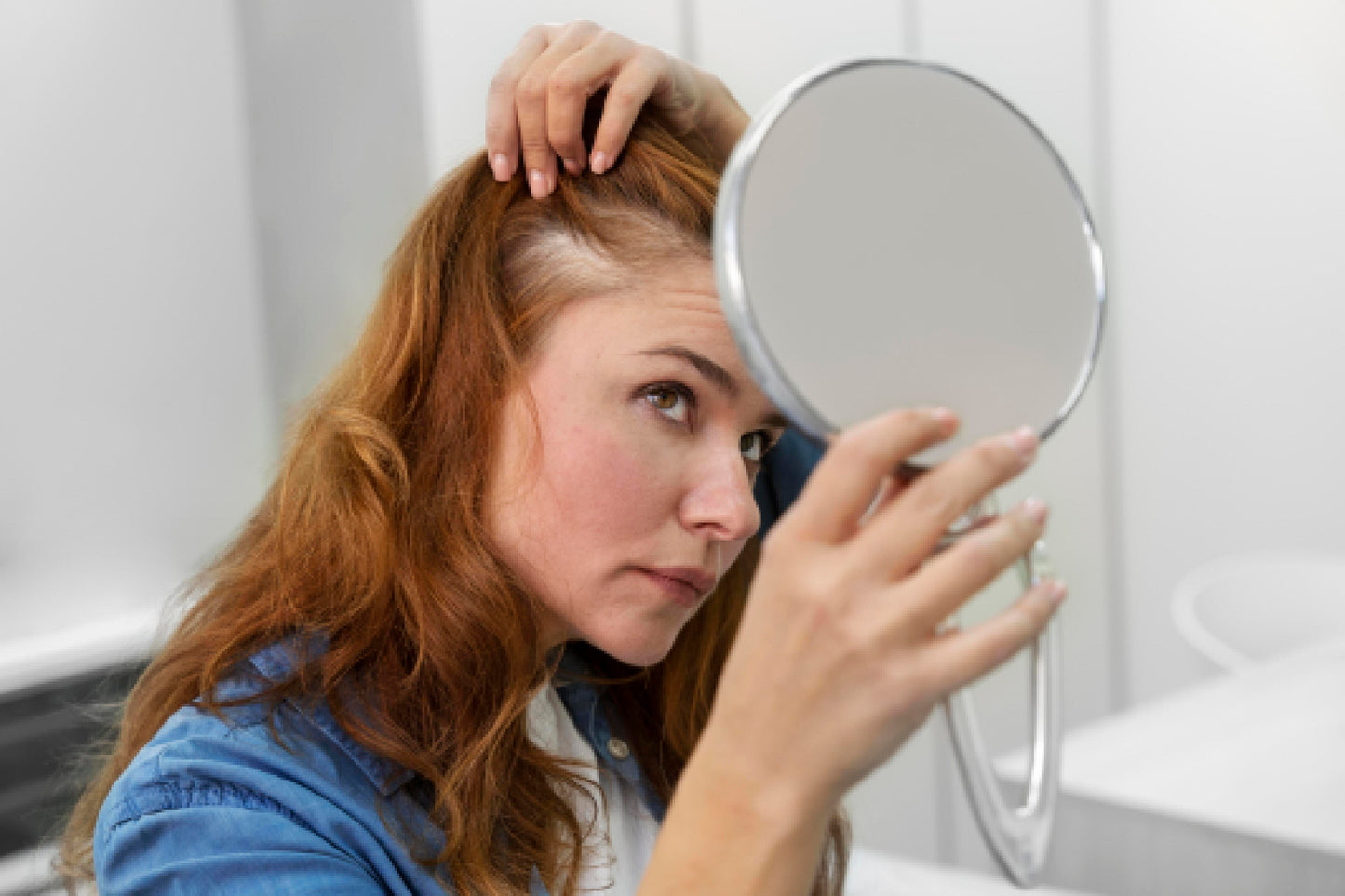
It is normal to find hair in your brush. Losing hair normally does not have much effect on your appearance because your head has plenty to compensate for the daily loss.1
So, how much hair loss is normal?
Some amount of hair loss is normal for everyone and at every age. It is normal to lose somewhere from 50 to 100 strands of hair per day. Losing hair strands may be more evident in people with longer hair. Because each person's scalp contains 100,000 or more hair follicles, the loss of 100 or more hair strands per day does not significantly impact the look.2
Can you tell if you are losing too much hair?
One can do a "pull test" on your hair at home. Begin by running your fingers through a small section of clean, dry hair, gently tugging as you reach the ends of your hair strands. One might have telogen or anagen effluvium if more than two or three hairs remain in the palm after each tug. Not more than 10 hairs per 100 strands should fall off when tugged.2
But, observing more hairs than usual on your pillow or hairbrush can be a cause of concern. You could simply be shedding more hair than usual. 3
What is Hair Shedding?
A shed hair is one that we can find on our fingers, comb or brush, pillow or clothing. Hair shedding is a natural part of the hair cycle that occurs regularly. Understanding the hair growth cycle might help us grasp the difference between normal and pathological hair shedding. A variety of factors can disrupt the hair development cycle, which can cause excessive hair shedding.4

What is the Cause of Hair Shedding?
Excessive hair shedding is common in people who have experienced any of the following stressors:
- Lost >20 pounds
- You have given birth
- Experience lots of stress (caring for a loved one who is sick, going through a divorce, losing a job, etc.)
- Had high fever
- Undergone an operation
- Recover from an illness, particularly if it includes a high fever
- Stopped taking birth-control pills3
Excessive hair shedding is usually noticed a few months following a stressful event. For example, a new mother may notice increased hair shedding about two months after giving birth.3 Approximately four months after giving birth, the shedding normally peaks, and this is normal and only lasts a short time. Excessive shedding stops as your body readjusts, and the hair tends to regain its original fullness within six to nine months.
Hair shedding, on the other hand, might last a long time if the stressor persists. Excessive hair shedding can occur in the long term in those who are continually under a lot of stress, and hair shedding often stops on its own.
Excessive hair shedding occurs when the body sheds significantly more hair each day. Telogen effluvium is the medical word for this disorder.3 Excessive hair shedding causes diffuse thinning of the hair, which makes the scalp more visible or bald. Hair shedding can lead to overall hair thinning.4,5
What is Hair Thinning?
People lose 50–100 hairs each day, and the new hair then regrows from the same hair follicles. But, with time, some follicles stop producing hair, and hair shafts become finer and also start to lose their color. 5

People's hair may begin to lose volume and thickness as they grow older. Thinning hair is sometimes associated with a diet, nutrient deficiencies, or hereditary hair loss. Unlike widespread hair loss, Thinning hair does not always lead to baldness. It does, however, make one’s hair appear sparser in some areas of the head.5,6
A person may be having hair loss if they notice considerable hair thinning or the appearance of bald patches. Because thinning hair usually starts gradually, one has plenty of time to figure out what's causing it and the best treatment options.
Hair thinning is more common in men from the hairline to the back of the head, while in women, it usually affects the crown of the head. 5,6
What causes thinning hair?
Thinning hair may be caused by lifestyle factors, genetics, recent life events (such as extreme weight loss in a short period or giving birth), or medical conditions. 5,6
Lifestyle habits may include:
- Over-treating hair: Color treatments, perms, relaxers or certain hair products, etc.
- Using harsh hair products: Extreme-hold hair sprays and gels.
- Wearing tight hairstyles: Wearing an up-do or pulling hair up in a ponytail for working out can tug the hair and break it from the follicles, which can cause thin spots over time.
- Not getting enough specific vitamins and minerals in the diet: Iron, folic acid, and other minerals in the diet can help follicles produce hair naturally.
- Experiencing high-stress levels: Stress is related to an uptick in hormones like cortisol which can kill off new hairs that are trying to grow. 5,6

-
Thinning hair may also be hereditary or from underlying medical conditions. One might have thinning hair if one -
- Androgenetic alopecia is a common form of hair loss. The pattern differs between women and men.
- Treated for an autoimmune disease
- Have immune system deficiencies
- Have a skin disorder or infection
- Have a vitamin d deficiency5,6,7
Thinning hair less commonly can also be caused by -
- Pulling own hair
- Eating disorders
- A high fever5,6
Why is hair thinning occur suddenly?
A period of great stress, pregnancy, discontinuing the use of birth control pill, hormonal changes, a high fever, or yanking the hair could all be factors responsible for sudden hair thinning. Sudden and persistent hair thinning and hair falling out in clumps could indicate an underlying medical issue. If this happens, talk to your doctor.5
Can thinning hair grow back?
Depending on what caused the hair to thin in the first place, it may grow back. Regrowth may occur in those who have thinning hair owing to nutritional deficiencies, stress, pregnancy, and other non-genetic factors. It is recommended to consult a doctor if one is experiencing new hair loss or hair thinning. 5Some cases of thinning hair can be treated at home. Some of the treatment options for hair thinning are –
- Scalp massage
- Use of Essential oils - e.g., lavender, rosemary, and thyme oil
- Anti-thinning shampoo - Provides volume to the hair and promotes a healthier scalp.
- Multivitamins - Iron, folic acid, and zinc to keep hair growing thick and strong.
- Omega-3 and omega-6 fatty acids - Might benefit the scalp.
- Medications: For Example., Minoxidil and Finasteride5
When to Consult a doctor for thinning hair?
You don't have to suffer in silence if you are concerned about the amount of hair that's falling out, persistent hair loss or a receding hairline, or if you notice sudden patchy hair loss. One can consult a dermatologist who can help determine whether your hair loss is due to normal shedding or not. For many types of hair loss, there are effective treatment alternatives. 2,3,5
Conclusion:
It is not uncommon to lose hair strands daily. Talk to your doctor if concerned about clumps of hair in the hairbrush or the shower drain. Hair loss can be aggravated by a variety of factors, including stress, medication, and underlying medical issues. A professional evaluation might help you relax.
While thinning hair may seem alarming at first, many types of thinning hair can be treated. You should see a doctor if you are having new hair loss or thinning or if you are growing bald areas. They can diagnose any underlying medical issues and prescribe any necessary drugs.
References:
- Why Is My Hair Falling Out? https://www.healthline.com/health/beauty-skin-care/why-is-my-hair-falling-out, last accessed on 26th April 2022.
- Routine Hair Shedding: Why It Happens and How Much to Expect, https://www.healthline.com/health/how-much-hair-loss-is-normal, last accessed on 26th April 2022.
- DO YOU HAVE HAIR LOSS OR HAIR SHEDDING? tps://www.aad.org/public/diseases/hair-loss/insider/shedding last accessed on 26th April 2022.
- Hair Shedding, https://dermnetnz.org/topics/hair-shedding, last accessed on 26th April 2022.
- 12 Ways to Stop Hair Thinning, https://www.healthline.com/health/thinning-hair, last accessed on 26th April 2022.
- Causes and treatments for thinning hair, https://www.medicalnewstoday.com/articles/325307, last accessed on 26th April 2022.
- Androgenetic alopecia, https://medlineplus.gov/genetics/condition/androgenetic-alopecia/ last accessed on 26th April 2022.






